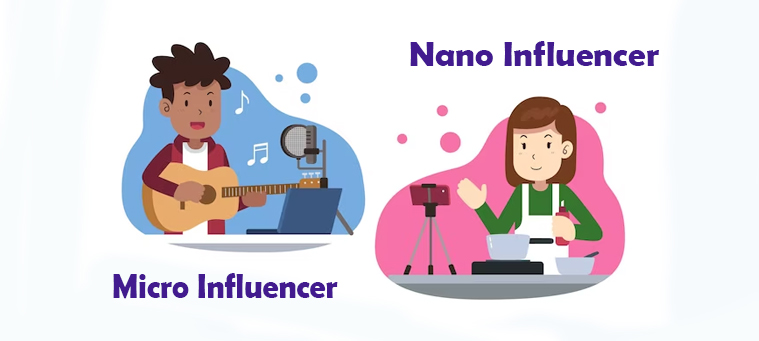In the world of social media marketing, there are two main types of influencers that brands work with – micro influencers and macro influencers. While both can be effective at driving engagement and sales, they operate on very different scales and offer different benefits.
Micro influencers are niche social media users with small but highly engaged audiences, usually under 100k followers. Their authenticity allows them to generate high engagement rates with targeted audiences. Macro influencers have follower counts in the millions and broad mass appeal, lending themselves to increasing rapid brand awareness. While micro influencers are seen as more relatable, macro influencers boast extensive reach.
In this article, we’ll explain the unique benefits of partnering with micro versus macro influencers and how you can choose the right fit for you.

Key Differences Between Micro & Macro Influencers
Micro and macro-influencers vary heavily in terms of audience size and campaign costs but both remain powerful marketing tools.
| Micro Influencers | Macro Influencers | ||
| Follower Count | 1,000 – 100,000 | Over 1 million | |
| Content Focus | Niche interests and topics | Broad, mass appeal | |
| Engagement Rates | Higher (up to 8% engagement) | Lower (1-2% engagement) | |
| Perceived Authenticity | More relatable and authentic | Seen as less accessible | |
| Accessibility for Brands | More approachable and affordable | Highly selective and expensive | |
| Cost Per Sponsored Post | $100 – $500 on average | $250,000+ on average | |
| Ideal Campaign Objective | Driving engagement and conversions | Rapidly increasing brand awareness | |
| Key Takeaway | Better for niche targeting and engagement | Better for broad reach and awareness | |
Now let’s take an in-depth look at things discussed below.
Engagement Levels and Authenticity
When it comes to engagement rates, micro influencers tend to outperform macro influencers. According to a study by Experticity:
Micro influencers with 1,000 to 10,000 followers generate likes at a rate of 4.5%, compared to macro influencers with over 1 million followers who achieve 1.7% engagement.
Micro influencers are also perceived as more authentic and relatable. A study by Markerly found that posts by micro influencers were liked twice as often as posts from accounts with over 1 million followers. Their lives and content feel more realistic versus the glamorous existence portrayed by top celebrity influencers.
Access and Cost Differences
One of the challenges of partnering with mega influencers is simply getting access and securing partnerships. Macro influencers are in high demand and highly selective about the brands they promote. Micro influencers are more approachable and affordable for most small budgets.
A Mediakix study found the average sponsored Instagram post price is $83 for micro influencers compared to $308,000 for macro influencers.
Micro influencers do require more relationship management as brands often need to partner with multiple micro influencers to achieve broader reach. However, the combined costs tend to still be modest compared to one macro influencer partnership.
Content Authenticity
Micro-influencers rely heavily on fostering genuine connections with their loyal supporters. Followers identify closely with them and deem their content highly authentic, original, and relevant to the niche. As opposed to polished studio productions, their photos and videos feature real situations and recommendations.
Macro-influencers on the higher end produce high-quality content frequently created by production teams with the aim of appealing to a mass demographic rather than a particular segment.
Advantages of Micro-Influencers
The strengths of micro-influencers make them extremely useful for certain marketing objectives:

Focused on Niche Markets
Micro-influencers allow brands to tap into highly specific consumer segments that are carefully aligned with the product. A skincare brand targeting teenage girls would have significant success partnering with micro beauty vloggers.
Enhanced Brand Likeness
Followers are more likely to trust product recommendations from micro-influencers they personally relate with. This translates into higher odds of driving genuine sales conversions rather than superficial brand mentions. The close-knit community around micro-influencers allows for brand affinity to flourish.
Cost-Effective
Micro-influencer campaigns are a financially lean way for brands to explore influencer marketing and identify revenue opportunities. $500 spent could reach 25,000 niche followers and generate actionable data through custom discount codes on actual sales influenced by the brand mention.
Advantages of Macro-Influencers
Macro-influencers carry distinct marketing advantages stemming from their unparalleled scale and visibility:

Greater Brand Awareness
Mass celebrity endorsements and sponsorships are a proven method for catapulting a brand into mainstream visibility. Even a single Instagram post from an athlete with 10 million followers can radically boost brand impressions and familiarity overnight.
Authority and Influence
Big names lend their credibility and industry authority to the brands they choose to collaborate with. Consumers actively seek out product recommendations from the influential figures they admire, whether celebrities, artists or thought leaders. The halo effect leads brands to be perceived more positively.
Viral Content Distribution
Content created organically by macro-influencers catches on rapidly and circulates across social media channels. Leveraging platforms like TikTok or YouTube broadens content reach even further, triggering viral effects that capture huge amounts of eyes. Brand mentions are woven into engaging stories instead of pushy ads displayed to unwilling customers.
How to Choose the Right Fit for Your Campaign
The choice between micro or macro-influencer partnerships depends entirely on campaign goals and target demographic. Here are some key considerations:

Find Your Marketing Objectives
Brands seeking mainstream reach for maximizing awareness tend to leverage macro-influencers better. Micro-influencer collaborations are ideal for calibrated engagement within a certain niche. Determine priorities between breadth of communication and depth of specialized engagement.
Consider Your Budget Limitations
Working with popular social media stars and mainstream celebrities requires a significant marketing budget. Micro-influencers provide specialized audience access at a fraction of the cost. Brands low on budget can explore micro-campaigns as test runs before investing heavily.
Find the Proper Brand Alignment
Micro-influencers are often the best fit when brands require precise alignment between an advocate’s niche and product specialization. However, big names lend credibility and aspirations appeal even when not directly connected to the product itself.
Measure Campaign ROI
It is important to track attributable conversions generated by influencer posts whether through custom promo codes or links. Engagement rates alone do not provide the full picture. Actual sales numbers indicate the revenue value different tiers of influencers contribute.
Influencer Marketing Success Stories
Here are some examples demonstrating how both micro and macro-influencers have delivered results for brands:
Micro Influencers
Manly Bands: This men’s silicone ring brand leveraged micro influencers on Instagram and TikTok and focused on male fashion and lifestyle. By getting product placements and reviews in front of their combined 600K targeted followers, site traffic rose 22% and ring sales increased 18%.
Coral & Gold: This small accessories brand focuses on festival fashion and jewelry. Working with a collective of mid-tier 10K-50K micro influencers on Instagram with brightly colored aesthetics, they increased new customer sign-ups by 31% over 2 months.
Macro Influencer
Iconic Protein Drinks: This nutrition startup was struggling to stand out in a crowded market until it sent free samples to The Rock and other celebrities and athletes. After The Rock posted on Instagram praising their protein shakes to his 300 million followers, Iconic sold out repeatedly over the next 6 months.
Haus Laboratories: Lady Gaga’s makeup brand partnered with her as their sole macro-influencer given her iconic status and enormous fanbase. By instantly tapping into Little Monster loyalty, Haus Labs pre-sales made $20 million in under a week before products even shipped.
Ready to start using influencer marketing to promote your product? Get started with our influencer marketing service today for a greater yet cost-effective organic reach.
Frequently Asked Questions and Answers
What engagement rate is considered good for micro vs macro influencers?
As a benchmark, micro-influencers often achieve engagement rates of 3-10% per post meaning each piece of content generates likes/comments from 3-10% of their total following. For macro-influencers given huge fan bases, average engagement falls between 1.5-3%.
Should my influencer marketing budget focus exclusively on micro or macro influencers?
An effective influencer marketing strategy incorporates both micro and macro-influencers to maximize results. An 80/20 distribution tends to work well – 80% towards micro-influencer content collaborations driving engagement coupled with 20% allocation to a few big-name macro-influencers for mainstream reach.
What analytics tools can help identify and manage influencers?
Platforms like Upfluence, Julius, AspireIQ, and Grin allow brands to search vast influencer databases by audience demographic as well as track campaign management metrics related to reach, engagement, and conversions.

